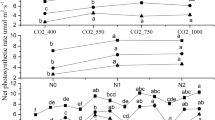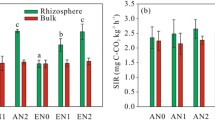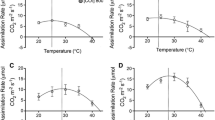Abstract
Yellow-poplar (Liriodendron tulipifera L.) seedlings were planted in unfertilized forest soil in boxes with a removable side panel and grown in atmospheres containing either ambient (367 μl l−1) or elevated (692 μl l−1) CO2. Numbers of total bacteria, nitrifiers, and phosphate-dissolving bacteria in the rhizosphere and in nonrhizosphere soil were measured every 6 weeks for 24 weeks. Seedling growth and nutrient content were measured at a final whole-plant harvest. Root, leaf, and total dry weights were significantly greater, and specific leaf area was significantly less, in 692 ml l−1 than in ambient CO2. Uptake per gram plant dry weight of N, S, and B was lower at elevated CO2, whereas uptake of P, K, Cu, Al, and Fe was proportional to growth in both CO2 treatments. Total uptake and uptake per g plant dry weight of Ca, Mg, Sr, Ba, Zn, and Mn were not affected by CO2 treatment. Bacterial populations differed due to CO2 only at the final harvest, where there were significantly fewer nitrite-oxidizers and phosphate-dissolving bacteria in the rhizosphere of seedlings grown at 692 μl l−1 CO2.
Similar content being viewed by others
References
Alexander M 1961 Introduction to Soil Microbiology. John Wiley and Sons, New York, 467 pp.
Alexander M and Clark F E 1965 Nitrifying bacteria.In Methods of Soil Analysis. II. Chemical and Microbiological Properties. Ed. C E Black, pp 1477–1482. American Society of Agronomy, Madison, Wisconsin.
Allen P J 1942 Changes in the metabolism of wheat leaves induced by infection with powdery mildew. Am. J. Bot. 29, 425–435.
Azcon R, Barea J M and Hayman D S 1976 Utilization of rock phosphate in alkaline soils by plants inoculated with mycorrhizal fungi and phosphate-solubilizing bacteria. Soil Biol. Biochem. 8, 135–138.
Babiuk L A and Paul E A 1970 The use of fluorescein isothiocyanate in the determination of the bacterial biomass of grassland soil. Can. J. Microbiol. 16, 57–62.
Baker D N and Enoch H Z 1983 Plant growth and development.In CO2 and Plants. Ed. E R Lemon. pp 107–130. AAAS Selected Symposium 84, Westview Press, Boulder, Colorado.
Daley R J and Hobbie J E 1975 Direct counts of aquatic bacteria by a modified epifluorescence technique. Limn. and Ocean. 20, 875–882.
Epstein E 1972 Mineral Nutrition of Plants: Principles and Prospectives. John Wiley and Sons, New York, 412 pp.
Fenwick L 1973 Studies on the rhizosphere microflora of onion plants in relation to temperature changes. Soil Biol. Biochem. 5, 315–320.
Fisher R A and Yates F 1963 Statistical Tables for Biological, Agricultural, and Medical Research Oliver and Boyd, London, 146 pp.
Fresquez P R and Lindemann W C 1982 Soil and rhizosphere microorganisms in amended coal mine spoils. Soil Sci. Soc. Am. J. 46, 751–755.
Gray L E and Gerdemann J W 1967 Influence of vesicular-arbuscular mycorrhizas on the uptake of Phosphorus-32 byLiriodendron tulipifera andLiquidambar styraciflua. Nature 213, 106–107.
Harley J L and Smith S E 1983 Mycorrhizal Symbiosis. Academic Press, New York, 483 pp.
Katznelson H, Peterson E A and Rouatt J W 1962 Phosphatedissolving microorganisms on seed and in the root zone of plants. Can. J. Bot. 40, 1181–1186.
Kauri T 1980 Rapid multipoint method for quantification of various physiological groups of bacteria in soil. Soil. Biol. Biochem. 12, 125–130.
Kimball B A 1983 Carbon dioxide and agricultural yield: An assemblage and analysis of 430 prior observations. Agron. J. 75, 779–788.
Kramer P 1981 Carbon dioxide concentration, photosynthesis, and dry matter production. Bioscience 31, 29–33.
Leaf A L 1973 Plant analysis as an aid in fertilizing forests. pp 427–454.In Soil Testing and Plant Analysis, Eds. L M Walsh and J D Beaton. Soil Science Society of America, Madison, Wisconsin.
Luther F M and Cess R D 1985 Review of the recent carbon dioxide-climate controversy.In Projecting the Climatic Effects of Increasing Carbon Dioxide. Eds. M C MacCraken and F M Luther, pp 321–335. DOE/ER-0237, US Department of Energy, Washington, DC.
Norby R J, Luxmoore R J, O'Neill E G and Weller D G 1984 Plant responses to elevated atmospheric CO2 with emphasis on belowground processes. ORNL/TM-9426, Oak Ridge National Laboratory, Oak Ridge, Tennessee 37831, 141 pp.
Norby R J, O'Neill E G and Luxmoore R J 1986 Effects of atmospheric CO2 enrichment on the growth and mineral nutrition ofQuercus alba seedlings. Plant Physiol. 82, 83–89.
O'Neill E G, Luxmoore R J and Norby R J 1985 Stimulation of mycorrhizal colonization at elevated atmospheric CO2. Bull. Ecol. Soc. Am. 66, 240.
Paul N B and Sundara Rao W V B 1971 Phosphate-dissolving bacteria in the rhizosphere of some cultivated legumes. Plant and Soil 35, 127–132.
Raj J, Bagyaraj D J and Manjunath A 1981 Influence of soil inoculation with vesicular-arbuscular mycorrhiza and a phosphate-dissolving bacterium on plant growth and32P-uptake. Soil Biol. Biochem. 13, 105–108.
Rouatt J W and Katznelson H 1960 Influence of light on bacterial flora of roots. Nature 186, 659–660.
Rouatt J W, Peterson E A, Katznelson H and Henderson V E 1963 Microorganisms in the root zone in relation to temperature. Can. J. Microbiol. 9, 227–236.
Routien J B and Dawson R F 1943 Some interrelationships of growth, salt absorption, respiration, and mycorrhizal development inPinus echinata. Mill. Am. J. Bot. 30, 440–451.
Scaglia J, Lensi R and Chalamet A 1985 Relationship between photosynthesis and denitrification in planted soil. Plant and Soil 84, 37–43.
Solomon A M, Trabalka J R, Reichle D E and Voorhees L D 1985 The global cycle of carbon.In Atmospheric Carbon Dioxide and the Global Carbon Cycle. Ed. J R Trabalka, pp 3–13. DOE/ER-0239, US Department of Energy, Washington, DC.
Thomas J F and Harvey C 1983 Leaf anatomy of four species grown under continuous CO2 enrichment. Bot. Gaz. 144, 303–309.
Tinker P B and Sanders F E 1975 Rhizosphere microorganisms and plant nutrition. Soil Sci. 119, 363–368.
Van Vuurde J W L and DeLange A 1978 The rhizosphere microflora of wheat grown under controlled condition. II. Influence of the stage of growth of the plant, soil fertility, and leaf treatment with urea on the rhizosphere soil microflora. Plant and Soil 50, 461–472.
Vrany J 1963 Effect of foliar application of urea on the root microflora. Folia Microbiol. 8, 351–355.
Author information
Authors and Affiliations
Additional information
Research sponsored by the Carbon Dioxide Research Division, U.S. Department of Energy, under Contract No. DEAC15-840R21400 with Martin Marietta Energy Systems, Inc. Publication, No. 2981. Environmental Sciences Division, ORNL.
Rights and permissions
About this article
Cite this article
O'Neill, E.G., Luxmoore, R.J. & Norby, R.J. Elevated atmospheric CO2 effects on seedling growth, nutrient uptake, and rhizosphere bacterial populations ofLiriodendron tulipifera L.. Plant Soil 104, 3–11 (1987). https://doi.org/10.1007/BF02370618
Received:
Revised:
Issue Date:
DOI: https://doi.org/10.1007/BF02370618




